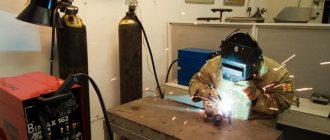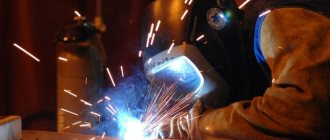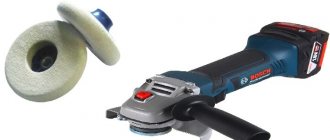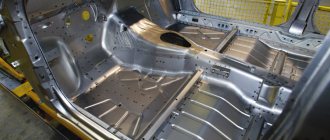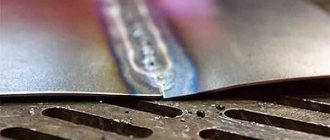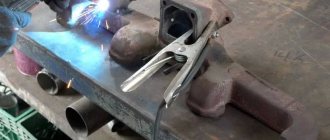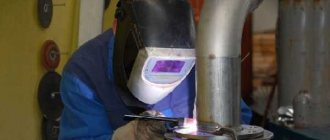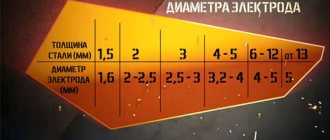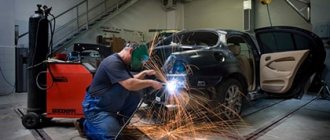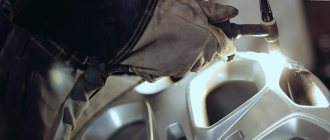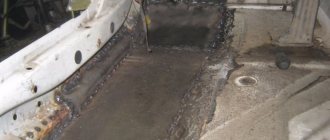Welding at a service station
Welding of machines at service stations is carried out by professional craftsmen. Preference is given to inverter welding. At service stations, it is possible to carry out welding work for a car in hard-to-reach places, for example, on the bottom of the car.
Before returning the car from repair, it is washed and the interior is cleaned.
Is it possible to cook a car body with an inverter?
When purchasing a used vehicle, you need to carefully examine it for various deficiencies. In this matter, any minor nuances are important, since in the future they can result in big problems.
When choosing a car, many potential buyers pay attention only to the technical characteristics, condition of the engine, transmission, chassis and other related elements that set the car in motion.
Accordingly, due attention is not paid to checking the newness and integrity of the body, although the condition of this part of the vehicle is also of paramount importance.
Welding with a car inverter allows you to weld in hard-to-reach places.
Experts note that the body of cars produced by the domestic auto industry can have its original characteristics for up to 10 years of active use, after which it begins to wear out and rot. Imported cars are more durable in this regard; their body can last up to 15 years. This is due to the high quality of the metal used in the production of car bodies.
Main areas of body rot that require welding
Figure 1. Welding the body with an electrode is undesirable, as noticeable seams are formed.
At the end of its service life, the vehicle body enters a rotting phase, so it is necessary to identify the affected areas and repair them immediately. Of course, if you have the necessary material resources, you can replace the body completely.
But in other cases, they turn to welding for help. It successfully deals with corrosive areas. If you do not eliminate them in time, after a certain time they will completely affect the body, turning it into a sieve.
Despite the fact that a car is used for different purposes, corrosion damage to the body occurs in the same places. First of all, rotting begins in the lower part of the body and in areas where liquid, dirt and dust accumulate: under the wings, doors, in the front and rear parts.
Everything is clear under the wings and doors - these are the most contaminated areas of the car body. The front part is affected mainly due to the human factor, that is, dirt from shoes gets inside the cabin and settles under the floors. The area in the back of the car where the spare tire is stored usually begins to rot. Most motorists throw an uncleaned wheel there, so corrosion thoroughly affects this area.
This problem is widespread; it is difficult to do without major repairs. To solve this problem, special expensive welding equipment is often used, which is only available in automotive service centers. If your financial capabilities do not allow you to go there, you can do welding yourself. But to do this, you will need to understand the types of welding work and understand which ones are best suited for car body metal.
Do-it-yourself welding
Welding car parts can be done even by a home craftsman. Auto welding is possible if there is space to carry out this process and the enthusiasm of its owner. Is it possible to weld a car using conventional welding? Of course, because the main parts of the car are made of metal.
Of course, welding a car will require purchasing the necessary equipment, consumables and tools. You should also consider secure fixation. It should be noted that welding thin-walled parts is more complex and requires knowledge of the intricacies of this process.
The first question for a welder to carry out repairs on his own is what welding machine can be used to weld a car. It is convenient to do this with semi-automatic devices and inverters.
For auto repair, a welding machine may have its advantages and disadvantages. Before choosing a welding machine for a car, you should familiarize yourself with their characteristics and application features. The selected welding machine for a car will help eliminate all existing shortcomings and allow you to use your car for a long time.
Professional welding of your car body - types and advantages
The car body is an important part of the vehicle, like other components or parts. The body is at risk, being a buffer in contact with the external environment - the inevitable mechanical impact of surrounding objects, other vehicles and objects in road accidents is guaranteed to lead to breakdowns and disruption of the shape of parts and loss of external attractive appearance. Don’t forget about the aggressive influence of the environment - moisture, dirt and salt cause corrosion spots and cracks. In all of the above cases, car body repair is required.
Semi-automatic welding
Semi-automatic welding is the most common type of joining parts. Cars are no exception.
In a semi-automatic machine, the role of the electrode is played by a wire that is fed from a reel inserted into the device. The welding itself takes place in a protective gas environment.
Semi-automatic automatic welding has many advantages. With the help of this equipment, it becomes possible to easily reach parts located in hard-to-reach places for connection purposes. This method can be used to repair large cars and trucks. Using a semi-automatic machine, seams of various widths are made.
The design of a semi-automatic device differs from other similar equipment in the specificity of consumables - instead of electrodes, wire is used when welding. It is supplied automatically during the welding process, which is extremely convenient.
Repairing a car using semi-automatic welding is an effective method that leads to a good result without much effort. Using this equipment, you can repair parts with a thickness of 0.7 to 4 millimeters. Both thin wings and massive spars fit into this range. Semi-automatic welding of a car is the most acceptable option if you have to repair the car body.
Welding of various car parts is most often carried out by joining them. This eliminates the formation of unnecessary thickenings on the surface. Using this method, you can place small patches or inserts on the surface of the parts in the required places, provided that no significant force is applied to them in the future. The semi-automatic machine can perform various types of connections.
The edges of the parts to be joined must first be chamfered if the thickness of the parts exceeds two millimeters. In other cases, you can do without it. It is necessary to reduce the size of the gaps between the parts being connected to a minimum value, or it is better to do without them completely. The most popular method among automotive welders is the lap joint.
Automotive welding using a semi-automatic machine allows you to perform various types of seams:
- point;
- continuous overlap;
- continuous intermittent overlap;
- continuous intermittent butt joint.
With the spot welding method of semi-automatic car parts, the connection occurs by applying not a continuous seam, but separate points at certain intervals. The interval between them depends on the length of the connection. It can range from a few millimeters to several centimeters.
You can weld seams with a semi-automatic machine at different positions of the parts, and, consequently, the seam. The most convenient way is to weld from above in a horizontal position. Bottom welding can also be used in this position. In order to make a vertical seam, the parts to be welded must be located in a vertical plane. In this case, it is necessary to provide for the possibility of hot metal flowing down along the seam line.
Before starting welding, it is necessary to carry out preparatory operations to clean the surfaces and set up the semi-automatic machine. To weld thin surfaces, set “1”, “max”, and the smoothness of adjustment to “7”. For thick sheets, the settings “2”, “max”, “8” are more suitable.
If burns occur during semi-automatic welding, this means that too much current was selected. A drop of frozen metal may form on the surface, formed from the hot wire. It must be removed after finishing work.
If the wire is pressed too hard against the surface during operation, the feed mechanism may break. If the wire slides along the surface, this, on the contrary, means that the clamping force is not enough.
For body welding, a carbon dioxide semi-automatic machine will be most suitable. Its use will ensure reliable welding of parts up to six millimeters thick. It can weld both ferrous and non-ferrous metals.
Such a semi-automatic machine requires the use of carbon dioxide in a cylinder. A reducer is also needed to reduce pressure. For welding non-ferrous metals, it is advisable to use argon welding. The presence of flammable gas will require additional measures to ensure process safety.
A semi-automatic welding machine for welding a car is a guarantee of obtaining a beautiful, high-quality seam, so it is advisable to use it if you are welding on an expensive car.
How to choose a device
All seams made on inverter welding machines are visible. And the quality of such seams depends on what characteristics a particular device has. When choosing an inverter, you should consider the following parameters:
- resistance to unstable voltage : stability coefficient (protection coefficient) must be in the range from 20 to 25% (indicated on the device itself and in its documents);
- maximum permissible ambient temperatures at which the equipment must be operated (indicated in degrees Celsius and in the range from +40 to -40 degrees, which are optimal temperature values);
- values of the diameters of the electrodes used during welding (in particular, electrode No. 2 with a diameter of 2 mm is used for welding thin parts, for example, body metal on the fenders or doors of a car, and electrodes No. 4 with a thickness of 4 mm are used on thicker component elements of the car body) .
Approximate cost of inverters for welding on Yandex.market
You should not pay attention to the “hot start” or “anti-stick” functions, since they are initially included in all modern inverter machines in the “base” and are used by manufacturers as an advertising ploy in order to better present their product for inexperienced users.
Welding with inverter
Choosing an inverter is a good answer to the question of which welding machine to weld a car with. It is not difficult to deal with, so a do-it-yourself car repair welding machine in the form of an inverter is the most suitable option. The inverter has high performance.
Welding with a car inverter has the following advantages:
- rapid heating of welded surfaces;
- independence from the power grid;
- ease of arc ignition;
- economical electricity consumption;
- a small number of defects;
- ease of use.
To use it, you will need a 220 W power connection. You can start welding with an inverter only after thoroughly cleaning the surfaces to be joined. Using an inverter, you can also apply patches to problem areas.
The ease of use of welding with a car inverter is combined with high quality results. Is it possible to weld a car using inverter welding? The answer is ambiguous. Of course, it is possible, but it is advisable to do this by welding thick parts, which, in particular, include the bottom and side members. In addition, the considerable cost of this equipment should be taken into account. You can learn how to weld a machine using inverter welding by carefully studying the operating instructions supplied with the device.
To choose the right welding machine for your car in the form of an inverter, you should consider the following points:
- Resistant to voltage surges.
- Temperature limits at which equipment welded using an inverter can be used.
- Diameters of electrodes used in the inverter.
Electrodes with a diameter of two millimeters are used for thin parts - on the wings and doors, and with a diameter of four millimeters - for work on the body.
Before starting automotive welding work, you should pay attention to the humidity of the room where the process will take place and ensure its minimum value. This will reduce the chance of water droplets getting into the seam when welding, which can cause small pits and damage to the seam. In case of significant corrosion damage, the edges of the future seam are treated with a special primer.
Welding a car with an inverter is used if it is necessary to carry out repair work in the trunk area, under the wings, as well as other hidden areas of the car.
It is advisable to choose an inverter with continuous adjustment. When welding thin-walled car parts with an inverter, the polarity should be reversed. This will help avoid burns of parts and changes in their shape.
Electrodes used
Electrodes for welding thin metal must be selected with extreme care. This is due to the fact that even the slightest deviation from established standards leads to the appearance of serious defects
When considering which electrode to weld 2 mm metal, we note the following points:
- When choosing low current values, the most suitable electrodes are those with a diameter of 2 to 3 mm. This is due to the fact that too high an indicator leads to arc attenuation.
- The optimal temperature in the welding zone is 170 degrees Celsius. This is quite enough to pierce steel, but its structure is not transformed. Due to this effect, the coating begins to melt evenly, and the welder can change the shape of the seam.
- In most cases, an electrode that has a high-quality coating is used. Often the technology used involves the use of a burst arc, due to which the weld pool is small in size.
Electrodes for welding 2 mm
Welding thin metal with an inverter can only take place when using special electrodes that can stabilize the arc.
Electrodes for welding
If there are no special requirements for the aesthetic side of the weld or it will be located in an inconspicuous place, then welding a car with electrodes will be advisable. In order to create a strong connection, it is necessary to correctly select the electrodes. It mainly depends on the material of the car.
Is it possible to cook a car with electrodes? If conventional manual arc welding or an inverter is used for welding, then the use of electrodes becomes a necessity.
Electrodes for welding automotive iron are on sale in a wide range. When welding at home, we can recommend ANO electrodes. They combine well with any type of inverter, provide quick ignition of the arc, and are convenient to work with in all positions.
MP-3 type electrodes are also suitable for household welding. They are versatile and easy to use.
High quality welds will be achieved by using UONI brand electrodes. However, to work with them, it is advisable to have experience in how to weld a car with electrodes. However, this is justified, since a seam welded using these electrodes will have increased toughness to impact loads, which is extremely important for a car.
To repair a car, it is not recommended to purchase OZCH type electrodes, since their main purpose is welding cast iron.
The choice of electrodes also depends on the type of material being welded. For example, electrodes of the NZh-13 brand are suitable for stainless steel.
When purchasing electrodes, you must pay attention to their markings. It will indicate in what position welding can be done using them. For example, vertical or overhead positions may be excluded.
Welding a car with electrodes does not require the development of special skills and does not cause difficulties if you have previous experience. Arc welding is used to fasten metal parts with a thickness of 0.2-4 millimeters. These include parts of the car body.
In order to obtain a high-quality result after arc welding, it is necessary that the arc burns continuously. If you choose electrodes with a diameter of 4-5 millimeters, the arc will go out. This is explained by the fact that thin surfaces are welded with a small current - 10-75 Amperes.
For thin metals that make up car body parts, electrodes of small diameter should be used - 0.5-3 millimeters, depending on the thickness of the part. When welding with thin electrodes, it is better to use two methods - butt and overlap. When welding thin metals, there is no need to bevel edges.
If electrodes with basic coating are used, then the use of direct current is mandatory. For other types of coating, both direct and alternating current are suitable.
To avoid burn-through, the electrode must be held at an angle of 45 degrees during the welding process. It is better to move at an angle forward. The distance from the surface should not be too large. Proper storage of electrodes is essential. This guarantees the preservation of its basic properties, long service life, and a high-quality seam.
If the electrodes are still damp, then drying them will help correct the situation, which is convenient to do in an electric drying oven designed for this purpose.
After undergoing treatment in this equipment, the electrodes will again acquire their operational characteristics. This stove can also be used as a storage case.
For home use, you should not purchase a stationary stove, but a portable, or otherwise mobile one. They have a convenient handle for carrying. It is convenient to have pull-out shelves on which the electrodes are placed. The oven has temperature control.
The capacity of the furnace chamber has a limitation, which must be taken into account when purchasing electrodes for future use. A portable oven may only have a drying function, but not a calcination function. For each type of electrode, you should set your own mode - time and temperature.
Cold welding for metal
Cold welding is a special substance for joining metals without the need to heat them up. Thanks to the special composition, two metal parts, pressed tightly against each other, form an inseparable and durable connection.
The method of repairing car bodies using cold welding allows you to eliminate small and large defects and restore the original appearance of the vehicle.
What is cold welding and what does it consist of?
The main components of cold welding are: resin, filler and hardener. The last substance is responsible for hardening; it has a special chemical formula. The filler is designed to improve the viscosity of cold welding, and the resin is its main synthetic component.
To repair a car body, any cold welding for metal is suitable.
The main advantages of cold welding include:
- Rapid hardening, which occurs in 10-60 minutes;
- Ease of use, to do this you need to mix both components of cold welding, after which the resulting mass is used to connect the parts;
- Good properties regarding mechanical strength and withstand elevated temperatures.
Hardened cold welding can be processed in every possible way: grinding, drilling, sharpening.
Car body repair using cold welding for metal
To properly repair a car body using cold welding, it is necessary to properly prepare the metal.
Firstly, there should be no traces of paint, dirt or primer on the area of the body being repaired. Its surface must be cleaned to bare metal and completely free of dust. Also, if there is rust on the damaged area of the body, then you must get rid of it. Rust greatly harms welding, this was discussed on the website mmasvarka.ru.
Then, using gasoline, kerosene or solvent, it is necessary to thoroughly degrease the prepared surface. Only after all the above manipulations can you begin to repair the car body using cold welding.
How to carry out this procedure:
- If the temperature in the garage is 0 degrees or lower, then you should definitely heat the body surface to be repaired with a hair dryer;
- Then you need to take the required amount of cold welding and knead it thoroughly with your fingers. In this case, the resin, filler and hardener must mix well and become a homogeneous mass. If cold welding sticks to your hands, you can moisten them with water;
- After this, you should apply cold welding to the car body and smooth it well with a small spatula.
After hardening, and the time it may take varies, everything largely depends on the composition of the cold weld, you can begin processing the body. As mentioned above, hardened cold welding can be safely ground and even threaded if repair work requires it.
Body welding
When using a car for a long time, many body parts begin to rot. First of all, these include doors, sills, places under bumpers, fenders and wheels. This happens, in particular, because they are subject to heavy pollution.
To this we can add the inside of the trunk, especially if a spare wheel is placed in it, which is not always cleared of dirt. In order to remove areas that have begun to rot, repair work will be required.
Before starting, a careful inspection of the body is necessary so that you can see all the shortcomings and determine the amount of work to be done.
If it is necessary to weld body elements, the optimal solution would be to use a carbon dioxide semi-automatic machine. The answer to the question whether it is possible to weld a car using inverter welding will also be affirmative. The advantage will be the absence of a cylinder with a highly flammable gas and the adoption of additional safety measures in this regard.
Before welding the body, you must carefully inspect it and assess its state of cleanliness. To do this, the body will have to be disassembled, the wings and, if necessary, the doors removed. Traces of previous processing should be removed. First of all, you need to pay attention to the underbody, its sills and wheel arches, where rust most often appears.
Then you should identify the areas and their boundaries where repair or replacement is required. If the corrosion is superficial, it can be removed using chemicals. After this, anti-corrosion treatment is required.
All problem areas will have to be cut out and patches welded to these areas. Any pieces of metal are suitable for repairing the bottom, but it is still desirable that their composition matches the main one. It is necessary to adjust all the pieces to be welded to size, cut off the excess, and bend some. If new material is welded, it should fit as tightly as possible to the body. Welding is best done using the overlap method. This is especially true for the repair of thresholds, where a continuous seam is unacceptable.
In order to correctly set up a welding machine for auto repair, you should practice on pieces of metal of the appropriate thickness and weld them using this method. This will help make the settings correct. After the part is attached to the surface of the body, it must be secured in several places with short transverse seams so that it holds well.
Using an inverter, you can perform not only repair work, but also improve your car. Welding makes it possible to install additional equipment - a device on the roof for luggage, racks for additional lighting fixtures.
Rules for processing the body after welding
After all welding seams have been completed in full, they must be cleaned using a grinder. The result of such cleaning will be a complete picture of the condition of the seams, as well as whether there are unchecked areas. If there are such unwelded areas, it is necessary to perform repeated welding work on them.
If there are no uncooked areas, the next step is to prepare the body for sandblasting and subsequent painting. Such preparation most often consists of puttying all body elements that require this type of treatment.
Possible defects
When welding thin-walled products, the following defects may occur:
- Burns . This defect appears precisely because the parts are thin. A competent choice of current strength and optimal speed will help you avoid this.
- Deformation of parts . The heated surface may begin to stretch, changing its shape. To avoid this, you can try alternating the welded sections along the entire length of the seam to give them time to cool.
- Lack of penetration . This defect will make the product leaky. The car will become vulnerable to bad weather with precipitation. You should not choose too high a speed, configure the inverter correctly, and ensure that the electrodes match the type of base material.
- Swells . The current should not be too high. It is possible to use special substrates.
To weld thin-walled structures, drying and preliminary calcination of the electrodes is necessary.
Resistance spot welding
Resistance welding has been the dominant joining method in automotive manufacturing and repair since the 1930s. Spot welding is carried out by pressing the electrodes of the machine firmly against the metal of the body and a combination of intense heat created by a very high current in a short period of time. The metal of the body panels is melted at one point and welding occurs.
The advantage of spot welding is the speed of action, the accuracy of the resulting weld points and the strength of the connection.
Modern passenger cars have from 3,000 to 4,000 weld points that connect individual body parts into one structure.
There are spot welding machines used in body repair, the electrodes of which do not need to compress the welding area. The force is applied to only one sheet of metal, and the second sheet touches the first sheet and is connected to the ground. Such a device is convenient to use when access to the reverse side of the metal to which another metal panel is welded is impossible.
Resistance welding points are often not protected from corrosion because the areas between the joined panels are susceptible to attracting moisture. This problem is aggravated by the fact that when exposed to spot welding, all metal processing elements, such as galvanized coating, evaporate at the hot spots. This problem is reduced by using a special welding primer between the panels being welded. This soil contains a high percentage of zinc. It is capable of conducting current. After exposure to spot welding, zinc ions protect the weld site.
Welding plastic bumpers
Automotive welding involves repairing not only metal products, but also plastic ones. In modern cars, bumpers are made of plastic. They are among the most frequently damaged parts of a car because this cheap material is very fragile.
If scratches, chips and other minor defects appear, it is not necessary to completely replace the bumper. The solution to the problem is to repair the bumper by welding plastic. You can do this yourself by purchasing the necessary tools and materials.
To restore damaged plastic parts you will need the following materials:
- solvent necessary for pre-treatment of surfaces;
- thin soft wire;
- rod;
- thin steel mesh up to two centimeters wide for fixation;
- liquid plastic to protect staples from corrosion;
- primer;
- rubber spatula;
- razor blade;
- sandpaper;
- dye.
To weld plastic bumpers you will also need the following tool:
- Soldering iron for preparing seams.
- Special welding gun or heat gun.
- Surface grinder.
- Spray gun.
The part to be repaired should be removed from the machine and installed on a workbench, frame or other stand, securely fixing it. Do not over-tighten the fastener, as this may damage the fragile structure of the part and leave dents on it.
The bumper to be repaired must be cleaned of all dirt and traces of paint. Damaged areas should be sanded using sandpaper, a grinder or a surface grinder. This operation will reduce the divergence of existing cracks. If there are holes and chips, then their edges do not need to be processed. But if a crack is to be sealed, then processing of its edges is required.
It is necessary to set the heating temperature on the welding hair dryer or gun. It must correspond to the melting temperature of the plastic from which the bumper is made. The rods should also be made from this material. To check compatibility, you can perform a test weld on a piece of the bumper from its rear side.
When welding, to improve strength, you can use a metal mesh as reinforcement.
Use a soldering iron to widen the crack and lay a rod along it. To form a bead, a welding gun is used to perform reciprocating movements. To restore the previous appearance, use a razor blade to cut off that part of the rollers that protrudes on top of the surface.
If the damage was significant, then after welding is completed, the area should be coated with a primer using a rubber spatula and sanded. Then you need to cover the repaired area with paint that matches the color of the entire car.
DIY welding
It is possible to weld the body yourself if you have basic skills, especially using an inverter, which will reduce the cost of paying for skilled labor. However, you will have to get the appropriate equipment somewhere.
The best repair option for body damage is to replace it. But this is expensive, so welding is used to restore inexpensive cars that have low corrosion resistance, therefore, the prevalence of the repair method in question is high. Next, we consider semi-automatic carbon dioxide welding.
Preliminary actions
Before starting work, it is necessary to prepare the areas of the car body to be welded. Preparation consists of completely cleaning the metal from paint, rust and dirt.
Then they move on to preparing the welding equipment for work.
- First of all, they check the network for load capacity.
- Next, the welding machine is charged with wire. To do this, you need to remove the gas nozzle of the welding torch, unscrew its copper tip with a wrench, remove the pressure roller with the wire and set the polarity. This parameter is determined by the type of wire used. When using flux-cored wire, set a plus on the clamp, a minus on the torch, and vice versa for regular wire.
- After this, the end of the wire is inserted 10 - 20 cm into the feed channel and a pressure roller is inserted to keep it from falling off. In this case, the wire should fall into the groove of the drive roller.
Upon completion of the described operations, the device is connected to the network and the key on its handle is pressed, after which gas is supplied, then welding wire and current. In this case, you need to put on the wire and tighten the required copper tip and install the gas nozzle.
Welding Recommendations
During body work, all parts are usually welded except the front part, since during operation it bears minimal loads. For cars that do not comply with this rule, it is necessary to over-weld, first of all, the places where the front “legs” are attached to the cross beam. In any case, it is necessary to weld the seams of the pallet, pillars and rear part of the car body. The fenders and hood are usually not treated. It should be noted that the body has some weak points that are especially susceptible to destruction by corrosion, so these areas are most often welded.
The bottom can be boiled on both sides, but during work it is necessary to observe the temperature regime. This will preserve the structure of the seams and neutralize the harmful effects of the welding machine on the material.
It is necessary to cut the material in compliance with optimal conditions in order to avoid deterioration of its properties. It is better not to cook the bottom alone, since the sheet of metal needs to be positioned evenly, which is difficult to do alone. Upon completion of the work, the edges of the welded sheet of metal are ground and treated with primer or epoxy resin to ensure tightness. After overwelding is completed, it is necessary to treat the seams with a primer
In this case, special attention is paid to the seams of the pillars, pallet and rear part of the body.
A carbon dioxide semi-automatic machine can weld not only the body, but also the engine and muffler of the car. When working with the engine, it is necessary to use argon. This allows you to weld metals such as cast iron, stainless steel, ordinary steel, and aluminum, which make up most engine parts. Over-welding the muffler is carried out similarly to welding the bottom, that is, by applying a metal patch.
Very often, when purchasing a used car, buyers are faced with various problems with the condition of the body.
Before a transaction, it is necessary to pay great attention to even the most insignificant nuances, because they almost always have a strong impact in the future
When buying a used car, most people only pay due attention to the technical specifications, appearance, horsepower, etc. But strangely enough, the car body is practically not checked, but only briefly examined from the outside
It is worth saying that the inside of the body is not always in the same condition as the outside.
Most experts tell us that almost all models of domestic automobile production regularly maintain the original condition of the body during ten years of operation. Foreign cars outperform our cars in this regard; their bodywork can “maintain” its factory condition for fifteen years.
Welding technology
Since body metal is very thin (from 0.8 to 1 mm), welding work should be performed with special care. To do this, you must comply with the following technological rules:
When performing welding work, it is necessary to protect your eyes using a mask with darkened glass (the degree of darkening of the glass depends on what type of welding is used), your hands should be covered with gloves (gaiters) that prevent droplets of hot metal from entering the skin.
The welder's clothing cannot be synthetic, as it will be necessary to avoid the risk of fire.
